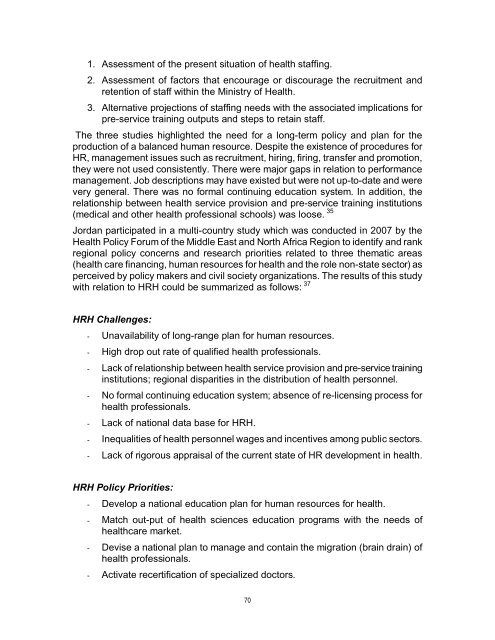Prepared by: Dr. Musa Ajlouni January, 2010 - World Health ...
Prepared by: Dr. Musa Ajlouni January, 2010 - World Health ...
Prepared by: Dr. Musa Ajlouni January, 2010 - World Health ...
You also want an ePaper? Increase the reach of your titles
YUMPU automatically turns print PDFs into web optimized ePapers that Google loves.
1. Assessment of the present situation of health staffing.2. Assessment of factors that encourage or discourage the recruitment andretention of staff within the Ministry of <strong>Health</strong>.3. Alternative projections of staffing needs with the associated implications forpre-service training outputs and steps to retain staff.The three studies highlighted the need for a long-term policy and plan for theproduction of a balanced human resource. Despite the existence of procedures forHR, management issues such as recruitment, hiring, firing, transfer and promotion,they were not used consistently. There were major gaps in relation to performancemanagement. Job descriptions may have existed but were not up-to-date and werevery general. There was no formal continuing education system. In addition, therelationship between health service provision and pre-service training institutions(medical and other health professional schools) was loose. 35Jordan participated in a multi-country study which was conducted in 2007 <strong>by</strong> the<strong>Health</strong> Policy Forum of the Middle East and North Africa Region to identify and rankregional policy concerns and research priorities related to three thematic areas(health care financing, human resources for health and the role non-state sector) asperceived <strong>by</strong> policy makers and civil society organizations. The results of this studywith relation to HRH could be summarized as follows: 37HRH Challenges:- Unavailability of long-range plan for human resources.- High drop out rate of qualified health professionals.- Lack of relationship between health service provision and pre-service traininginstitutions; regional disparities in the distribution of health personnel.- No formal continuing education system; absence of re-licensing process forhealth professionals.- Lack of national data base for HRH.- Inequalities of health personnel wages and incentives among public sectors.- Lack of rigorous appraisal of the current state of HR development in health.HRH Policy Priorities:- Develop a national education plan for human resources for health.- Match out-put of health sciences education programs with the needs ofhealthcare market.- Devise a national plan to manage and contain the migration (brain drain) ofhealth professionals.- Activate recertification of specialized doctors.70

















